Sea Glass |
||||||||||||||||||||||||||||||||||||||||||||||||||||||||||
 |
 |
|||||||||||||||||||||||||||||||||||||||||||||||||||||||||
Crochet jacket worked in a circle with lace pattern in DROPS Merino Extra Fine or DROPS Sky. Size: S - XXXL.
DROPS 164-16 |
||||||||||||||||||||||||||||||||||||||||||||||||||||||||||
|
CROCHET INFO: Beg every round with tr with 3 ch and finish with 1 sl st in 3rd ch at beg of round, ch does not replace first tr. Beg every tr row with 3 ch. DECREASE TIP: Dec 1 tr by working the next 2 tr tog as follows: Work 1 tr but wait with last pull through (= 2 sts on hook), then work next tr but on last pull through, pull yarn through all 3 sts on hook. PATTERN: See diagrams A.1-A.10. Diagram A.8 shows how round beg and ends. NOTE: In diagram A.2-A.4, A.6 and A.10 first round in diagram is last round on previous diagram, it is not worked but shows how to continue. ---------------------------------------------------------- CIRCLE: Work 5 ch on hook size 5 mm with Merino Extra Fine or Sky and form 1 ring with 1 sl st in first ch. Then work A.1 as follows: ROUND 1: Work 3 ch - READ CROCHET INFO, 12 tr in ch-ring, finish with 1 sl st in 3rd ch. ROUND 2: Work 2 tr in back loop of every tr = 24 tr. ROUND 3: Work * 2 tr in back loop of first/next tr, 1 tr in back loop of next tr *, repeat from *-* the entire round = 36 tr. REMEMBER THE CROCHET TENSION! Then work A.2 6 times in total on round. NOTE: A.8 in same diagram shows how every round beg and ends. Note if tr is worked in back loop, in or around st (applies for all diagrams). When A.2 has been worked 1 time vertically, there are 96 tr and 24 ch on round (= 120 sts in total). Piece measures approx. 28 cm in diameter. Then work A.3 12 times in total on round. When 2-3-4 rounds of A.3 have been worked (circle measures approx. 36-38-40 cm in diameter), there are 156-168-192 sts on round (= 156-168-96 tr and 0-0-96 ch). Now work armholes in the different sizes: SIZE S/M: Round now deviates from diagram because of armhole. Work as follows: Work 3rd round in A.3 as follows (all tr on this round are worked in back loop of tr): Work 3 ch, * 2 tr in first tr, 1 tr in each of the next 8 tr *, repeat from *-* 4 more times, 26 ch, skip 26 tr (= armhole), repeat from *-* 6 times in total, 1 tr in each of the next 5 tr AT THE SAME TIME inc 1 tr, 26 ch, skip 26 tr (= armhole), finish with 1 sl st in 3rd ch at beg of round = 116 tr (= 26 ch for each sleeve, 168 sts in total). Work 4th round in A.3 as follows (all tr worked in tr, are worked in back loop on this round): Work 3 ch, ** 1 tr in first/next tr/ch, 1 ch, * 1 tr in next tr/ch, 1 ch, skip 1 tr/ch *, repeat from *-* 4 more times, 1 tr in next tr/ch, 1 ch, 1 tr in next tr/ch, 1 ch, skip 1 tr/ch **, repeat from **-** 11 more times, work like this over ch-spaces (= sleeve) too, finish with 1 sl st in 3rd ch at beg of round = 96 tr and 96 ch (= 192 sts in total). Then work A.3 as before. When A.3 has been worked 1 time vertically, there are 192 tr on round. Then work A.4 24 times in total on round. SIZE L/XL: Round now deviates from diagram because of armhole. Work as follows: Work 4th round in A.3 as follows (all tr worked in tr, are worked in back loop on this round): Work 3 ch, ** 1 tr in first/next tr, 1 ch, * 1 tr in next tr, 1 ch, skip 1 tr *, repeat from *-* 4 more times, 1 tr in next tr, 1 ch, 1 tr in next tr, 1 ch, skip 1 tr **, repeat from **-** 2 more times, work 1 tr in next tr, 1 ch, 1 tr in next tr, 1 ch, skip 1 tr, 1 tr in next tr, 1 ch, skip 1 tr, 1 tr in next tr, work 28 ch, skip 28 tr (= armhole), repeat from **-** 4 times in total, work 1 tr in next tr, 1 ch, 1 tr in next tr, 1 ch, skip 1 tr, 1 tr in next tr, * 1 ch, skip 1 tr, 1 tr in next tr *, repeat from *-* 1 more time, work 28 ch, skip 28 tr (= armhole), finish with 1 sl st in 3rd ch at beg of round = 65 tr and 119 ch (= 28 ch for each sleeve, 184 sts in total). Work 5th round in A.3 as follows (all tr worked in tr, are worked in back loop on this round): Work 1 tr in every tr and 1 tr in every ch. Over ch-space for each sleeve work as follows: Work * 1 tr in each of the first 6 ch, 2 tr in next ch *, repeat from *-* 3 more times, finish with 1 sl st in 3rd ch at beg of round = 192 tr. Continue working diagram A.3. When A.3 has been worked 1 time vertically, there are 192 tr on round. Then work A.4 24 times in total on round. SIZE XXL/XXXL: Round now deviates from diagram because of armhole. Work as follows: Work 5th round in A.3 as follows (all tr worked in tr, are worked in back loop on this round): Work 3 ch, * 1 tr in first/next tr, 1 tr around next ch *, repeat from *-* 24 more times, 1 tr in next tr, 30 ch, skip 15 tr and 15 ch (= 30 sts in total) for armhole, * work 1 tr around next ch, 1 tr in next tr *, repeat from *-* 39 more times, 1 tr around next ch, 30 ch, skip the last 15 tr and 15 ch (= armhole), finish with 1 sl st in 3rd ch at beg of round = 132 tr and 30 ch for each sleeve (= 192 sts in total). Then work A.4 24 times in total on round. Work first round as follows: Work 3 ch, * 3 ch, skip 3 tr/ch, 1 tr in next tr/ch, 3 ch, skip 3 tr/ch, 1 tr in next tr/ch *, repeat from *-* 23 more times, work like this over ch-spaces (= sleeves) too, finish with 1 sl st in 3rd ch at beg of round = 48 ch-spaces. ALL SIZES: When A.4 has been worked 1 time vertically, there are 240 tr on round. Piece measures approx. 54 cm in diameter. Then work A.5 24 times in total on round. When A.5 has been worked 1 time vertically, there are 336 tr on round. Piece measures approx. 76 cm in diameter. Then work A.6 42 times in total on round AT THE SAME TIME on last round of A.6 inc 2 tr evenly by working 2 tr in same tr. When A.6 has been worked 1 time vertically, there are 380 tr on round. Then work A.5 38 times in total on round as follows in the different sizes: SIZE S/M: Work 5 rounds of A.5 = 494 tr. Then work 1 tr in back loop of every tr AT THE SAME TIME inc 42 tr evenly (inc approx. 1 tr in every 12th tr) = 536 tr on round. Piece now measures approx. 110 cm in diameter. Then work A.6 67 times in total on round. Fasten off when the first 2 rounds of A.6 have been worked. Piece measures approx. 114 cm in diameter. SIZE L/XL: Work A.5. When A.5 has been worked 1 time vertically, there are 532 tr on round. Then work 1 tr in back loop of every tr AT THE SAME TIME inc 36 tr evenly (inc approx. 1 tr in every 15th tr) = 568 tr. Piece measures approx. 118 cm in diameter. Then work A.6 71 times in total on round. Fasten off when the first 2 rounds of A.6 have been worked. Piece measures approx. 122 cm in diameter. SIZE XXL/XXXL: Work A.5. When A.5 has been worked 1 time vertically, there are 532 tr on round. Then work 1 tr in back loop of every tr AT THE SAME TIME inc 36 tr evenly (inc approx. 1 tr in every 15th tr) = 568 tr. Piece measures approx. 118 cm in diameter. Then work A.6 71 times in total on round. When A.6 has been worked 1 time vertically, there are 639 tr on round. Piece measures approx. 125 cm in diameter. Work 1 round with 1 tr in back loop of every tr AT THE SAME TIME inc 9 tr evenly = 648 tr. Work A.6 81 times in total on round. Fasten off when the first 2 rounds of A.6 have been worked. Piece measures approx. 130 cm in diameter. SLEEVE: Worked back and forth, top down. First work a sleeve cap. Work A.7 - remember CROCHET INFO. When A.7 has been worked 1 time, there are 25 tr on round. Fasten off. Work 14-16-18 loose ch, then work 1 tr in every tr from A.7, finish with 17-19-21 ch (incl 3 ch to turn with). Insert 1 marker in piece, NOW MEASURE PIECE FROM HERE. Work 1 tr in 4th ch from hook, 1 tr in each of the next 13-15-17 ch, 1 tr in every tr, 1 tr in every ch = 53-57-61 tr. Then work 1 tr in every tr. When piece measures 4 cm, dec 1 tr in each side of piece by working the first 2 tr tog and the last 2 tr tog (= 2 tr dec) – SEE DECREASE TIP! Repeat dec every 3-3-3½ cm 10-10-9 more times = 31-35-41 tr. When piece measures 38-39-40 cm, work piece in the round as follows: Work A.9 6-7-8 times in total on round AT THE SAME TIME on first round dec 1-0-1 tr = 30-35-40 tr. On last round in A.9 dec 2-3-4 tr evenly = 28-32-36 tr. Then work A.10 7-8-9 times in total on round. Fasten off when A.10 has been worked 1 time vertically. Piece measures approx. 63-64-65 cm in total. Work another sleeve the same way. ASSEMBLY: Sew sleeves into circle in outer loop of edge sts. Sew underarm seam. |
||||||||||||||||||||||||||||||||||||||||||||||||||||||||||
Diagram explanations |
||||||||||||||||||||||||||||||||||||||||||||||||||||||||||
|
||||||||||||||||||||||||||||||||||||||||||||||||||||||||||
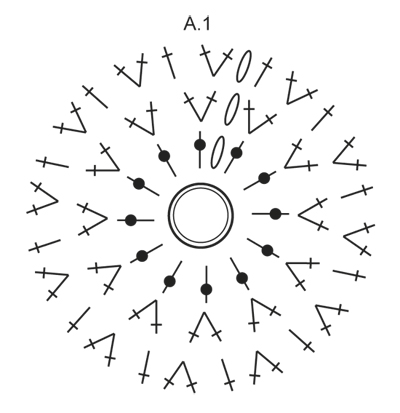
|
||||||||||||||||||||||||||||||||||||||||||||||||||||||||||

|
||||||||||||||||||||||||||||||||||||||||||||||||||||||||||

|
||||||||||||||||||||||||||||||||||||||||||||||||||||||||||

|
||||||||||||||||||||||||||||||||||||||||||||||||||||||||||

|
||||||||||||||||||||||||||||||||||||||||||||||||||||||||||
|
Have you made this or any other of our designs? Tag your pictures in social media with #dropsdesign so we can see them! Do you need help with this pattern?You'll find tutorial videos, a Comments/Questions area and more by visiting the pattern on garnstudio.com. © 1982-2024 DROPS Design A/S. We reserve all rights. This document, including all its sub-sections, has copyrights. Read more about what you can do with our patterns at the bottom of each pattern on our site. |
||||||||||||||||||||||||||||||||||||||||||||||||||||||||||







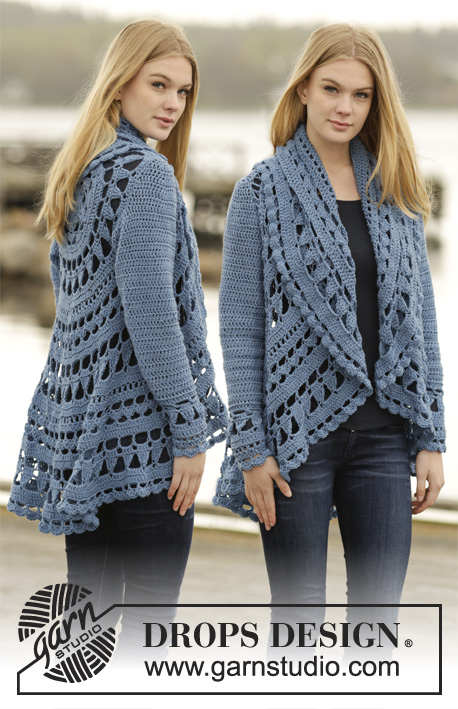


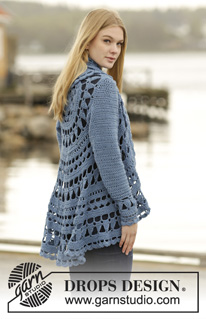
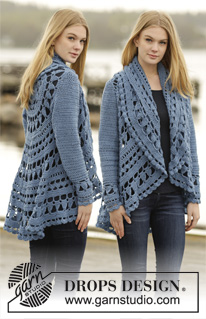
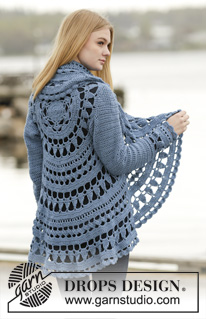





















































Comments / Questions (190)
I fell in love with this pattern. However, I don't know how to get from A2 sec 1 of 6 to sec 2 and so on? Thank you fir this beautiful pattern.
30.10.2019 - 21:11DROPS Design answered:
Dear Cindy, this should help you to figure out how to read crochet diagrams. Happy crocheting!
04.11.2019 - 13:52I read what you said about the sleeve but im still confused. where do you start doing the double stitches for the sleeve, is it on the chain you make , or do i chain from a7, or what ? help pleaseeeeee.
05.09.2019 - 23:47DROPS Design answered:
Dear Sandra, sleeves are worked separately from body; you first crochet A.7 = 3 chains, 1 sl st in 1st ch then work back and forth following diagram: on 1st row you work 7 dc in the chain-ring, then on 2nd row you work (2 dc in 1st dc, 1 dc in next dc) x 3 and finish with 2 dc in last dc, continue like this working A.7 back and forth. Happy crocheting!
06.09.2019 - 08:24When do you start working under the sleeve whole section
01.09.2019 - 21:46DROPS Design answered:
Dear Sandra, I'm afraid I don't get your question here. Sleeves are worked separately from body (circle) back and forth with a seam. For the section after armhole (chains) have been worked, see previous answers. Happy crocheting!
02.09.2019 - 11:02Does a4 go under arm hole or over?
31.08.2019 - 21:04DROPS Design answered:
Dear Sandra, you will work A.4 over the last row in A.3 = in the stitches from A.3 + in the chain-spaces for amrholes (so that there are 2 holes for each sleeve). Happy crocheting!
02.09.2019 - 10:16Ok I am having issues with the last part of the xxl size chart. It says to work a4 24 times but the arm holes are on that row. So what do I do?
30.08.2019 - 18:00DROPS Design answered:
Dear Sandra, you work the 5th row in A.3 shaping the armholes at the same time, then on next round, work A.4, ie repeat diagram a total of 24 times in width in the round , ie in the stitches from 5th row on A.3 as well as over the ch-spaces for the armholes = there are 48 ch-spaces in total at the end of 1st row in A.4. Work A.4 1 time in height. Happy crocheting!
02.09.2019 - 08:29But there are no spaces in the last row of a3 ?
30.08.2019 - 16:47Sandra answered:
Never mind i figured out
30.08.2019 - 17:54I am having trouble understanding the round when you start doing size for arm hole for the xxxl it is confusing. Is there away to understanding it better?
29.08.2019 - 23:56DROPS Design answered:
Dear Sandra, work the 5th row in A.3 as explained in the written pattern: work from *-* a total of 25 times, then 1 st in next st, chain 30 and skip the next 15 sts+15 chains (= hole for the sleeve), work from *-* a total of 40 times, 1 st in next chain, repeat armhole = 30 ch, skip next 15 sts + 15 chains and finish round wiht 1 sl st in 3rd ch from beg of round. On next round you will repeat A.4 a total of 24 times in width, crocheting in the stitches from A.3 as well as in the chains. Happy crocheting!
30.08.2019 - 09:39Is there a written version somewhere. I don't understand the diagram pattern.
27.08.2019 - 23:11DROPS Design answered:
Dear Sandra, there are only diagrams to this pattern, you will find here how to read crochet diagrams. Happy crocheting!
28.08.2019 - 08:55How can I contact a store and show them? I bought my yarn from Lindehobby do I send them pictures of my project and show them?
26.08.2019 - 17:35DROPS Design answered:
Dear Rina, yes, you can send them pictures per mail this might help them to help you showing your work, it will be easier for them to find a solution seeing your sleeves. Happy crocheting!
27.08.2019 - 09:02Hi, When I finished both sleeves and tried to sew them into the arm hole circle the left one looks ok but the right one has the 3 chain line (the 3 chain starter I mean) in front which looks a bit odd I think it should be at the back. Are both left and right arm start the same way when joining with the cap? I am not sure what to do as I followed exactly and it came out nice on the left arm. It's just the right arm that looks like it's done the other way.
26.08.2019 - 15:28DROPS Design answered:
Dear Rita, sleeves should be both the same, not sure how far we can help - you can maybe try to sew them so that there is no difference between both? Do not hesitate to show your store your work (even per mail), they might find the best solution looking at your pieces. Happy crocheting!
26.08.2019 - 16:20